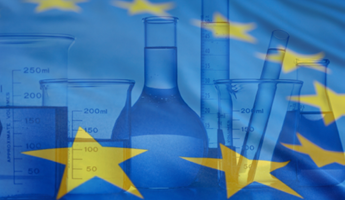Kestävyyttä edistävä kemikaalistrategia
-
Tieteen ajankohtaisia aiheita
- Syövän ehkäiseminen
- Ihoa herkistävät kemikaalit
- Perfluoroalkyylikemikaalit (PFAS-aineet)
- Mikromuovit
- Rakeet ja katteet urheilukentillä
- Tatuointi- ja kestopigmentointivärit
- Glyfosaatti
- Hormonitoimintaa häiritsevät aineet
- Bisfenolit
- Kestävyyttä edistävä kemikaalistrategia
- REACH-asetuksen vaatimukset eläinkokeille
- Ftalaatit
- Biocides
- Lyijy
- Research to enhance protection of our health and environment
Kestävyyttä edistävä kemikaalistrategia

Euroopan komissio hyväksyi kestävyyttä edistävän kemikaalistrategiansa 14. lokakuuta 2020. Strategia on osa EU:n nollapäästötavoitetta, joka on Euroopan vihreän kehityksen ohjelman keskeinen sitoumus. Sen tavoitteena on suojella kansalaisia ja ympäristöä haitallisilta kemikaaleilta entistä paremmin sekä tukea innovointia edistämällä turvallisempien ja kestävämpien kemikaalien käyttöä.
Euroopan vihreän kehityksen ohjelma on EU:n uusi kasvustrategia. Sen tavoitteena on muuttaa Euroopan talous kestäväksi ja hiilineutraaliksi ja samalla vastata covid-19-pandemian aiheuttamaan talouskriisiin ja seurauksiin.
Kemikaalit ovat keskeisiä rakennuspalikoita niin käyttämissämme tavaroissa kuin niissä huipputeknologian materiaaleissa, joita tarvitaan kiertotalouden ja ilmastoneutraalin talouden edistämiseen. Kemikaalien tuotanto on kuitenkin energiaa runsaasti kuluttava ja hiilidioksidia tuottava teollisuuden ala. Siirtyminen sellaisen kemikaali- ja tuotantoteknologian käyttöön, joka kuluttaa vähemmän energiaa, vähentää myös päästöjä. Euroopan vihreän kehityksen ohjelma tarvitsee siis niin sanotusti oikeanlaista kemiaa.
Kemikaaleihin erikoistuneena EU:n virastona ECHA osallistuu strategian toteuttamiseen tarjoamalla tieteellistä ja sääntelyyn liittyvää asiantuntemusta, tietokantoja, digitaalisia työkaluja ja verkostoja sekä kemikaalilainsäädäntöön liittyvää käytännön osaamista tarpeen mukaan.
EU:n organisaationa ja työnantajana ECHA sitoutuu omassa Euroopan vihreän kehityksen ohjelman lupauksessaan laajentamaan viraston ympäristösertifiointia ottamalla käyttöön EU:n ympäristöasioiden hallinta- ja auditointijärjestelmän (EMAS) sekä tekemällä ECHAsta ilmastoneutraalin vuoteen 2030 mennessä.
The Commission’s strategy provides an action plan to:
- Ban the most harmful chemicals in consumer products – allowing those chemicals only where their use is essential.
- Pay attention to the cocktail effect of chemicals when assessing chemical risks.
- Phase out per- and polyfluoroalkyl substances (PFAS) in the EU, unless their use is essential.
- Boost investment and innovative capacity for the production and use of chemicals that are safe and sustainable by design throughout their lifecycle.
- Promote the EU’s supply and sustainability of critical chemicals.
- Establish a simpler “one substance, one assessment” process for assessing the risks and hazards of chemicals.
- Play a leading role globally by championing and promoting high chemical safety standards and not exporting chemicals banned in the EU.
The Commission has asked ECHA to take an active role in the following work areas:
- Developing criteria for chemicals that are safe and sustainable by design.
- Assessing how to introduce mixture assessment factors in REACH.
- Establishing a “one substance, one assessment” process to coordinate hazard and risk assessment across chemicals legislation.
- Developing an indicator framework on chemicals as part of the Zero Pollution and 8th Environment Action Programme monitoring framework.
- Improving enforcement of chemicals legislation.
- Developing a strategic research and innovation agenda for chemicals.
- Developing EU-wide human and environmental biomonitoring in the context of the Partnership for the Assessment of Risk from Chemicals (PARC).
- Establishing an EU chemical early warning and action system.
In addition, ECHA will provide scientific and technical support for the impact assessment on planned revisions to REACH and CLP.
REACH revision
ECHA will support the amendment of REACH information requirements for substances that have critical hazard properties. The Agency is also involved in preparatory work for extending the registration duty to certain polymers, which currently do not need to be registered under REACH.
The Agency is a member in steering groups for studies and assessments on:
- information on volumes, uses, exposure/emissions and environmental footprint in REACH registrations;
- derived minimal effect levels (DMELs) for certain substances; and
- introducing a mixture assessment factor.
To improve the evaluation of chemicals, ECHA will provide information on the functioning of dossier and substance evaluation to the Commission with proposals to develop the two processes further.
To develop the use of the generic approach to risk management, ECHA will gather information on uses of certain hazardous substances. It will furthermore support the Commission in developing options to reform authorisation and restrictions. Additionally, the Agency will contribute to the development of criteria for essential uses of substances.
Until the generic approach to risk management is introduced and applicable in REACH, ECHA supports the development of criteria for prioritising substances and groups of substances for restrictions to establish a restrictions roadmap.
CLP revision
ECHA will assist the Commission in revising and developing new hazard criteria under the CLP Regulation for:
- persistent, mobile and toxic (PMT) and very persistent and very mobile substances (vPvM);
- terrestrial organisms;
- immunotoxicity and developmental neurotoxicity;
- endocrine disrupters; and
- persistent, bioaccumulative and toxic (PBT) and very persistent, very bioaccumulative substances (vPvB).
The Agency will assess the information it has available to identify substances that qualify for the new and further hazard classes or criteria and, where possible, set up a list of these substances.
European Commission
- Chemicals Strategy for Sustainability [PDF]
- Chemicals Strategy - background
- Chemicals Strategy implementation
- European Green Deal
- Commission's note to agencies on chemicals strategy 21 December 2020 [PDF]
- Commission's request to ECHA on chemicals strategy 12 April 2021 [PDF]
- Restrictions Roadmap
ECHA
- CLP Revision - ECHA input [PDF]
- ECHA's contributions to CSS work in 2023 [PDF]
- ECHA's contributions to CSS work in 2022 [PDF]
- ECHA's contributions to CSS work in 2021 [PDF]
- ECHA’s contribution to the Commission’s Restrictions Roadmap [PDF]
- ECHA news release 14 October 2020 - ECHA ready to help the EU achieve its ambitions for safe and sustainable chemicals


